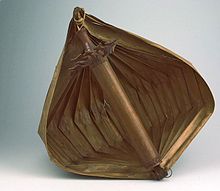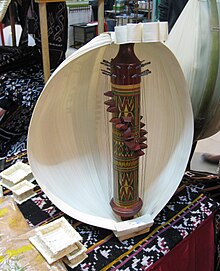Sasando
The sasando ( Malay ), also sesando , Rotinese : sasandu , is a heterochordial tubular zither made of bamboo with a bell. It is the national musical instrument of the people on the island of Roti in the Indonesian province of East Nusa-Tenggara .
Design and distribution
The resonance body consists of a bamboo tube section, from one knot end of which parallel metal strings are stretched to the upper end. The strings are held at the bottom by metal pins or a wire winding and stretched on the opposite side by pegs made of wood or metal. In simple instruments, the vertebrae protrude in a star shape from holes drilled in the bamboo tube. In addition, there are instruments that are refined from the basic form, with varying degrees of effort, such as “concertante” sasando s with an extra-wide wooden pegbox placed on the bamboo tube. With many instruments, both ends consist of an adapted piece of wood to which the strings are attached.
Until the 19th century the bamboo zithers were idiochord, they had about ten strips of bamboo peeled lengthways out of the tube as strings, which were stretched by sliding wooden blocks. Today thin copper wire is used for the 10 to 36 and more strings. Coupling wires from mopeds are used on simpler versions with ten to eleven strings. Each string is by one or two wedge-shaped wooden bars kept at a distance from the tube and tuned by shifting these webs and turning of the vertebrae. The length of the often artistically painted bamboo tube is around 50 to 70 centimeters.
A sasando gong has ten to eleven strings and can only play traditional music. The instrument is tuned pentatonic and has a range of two octaves. The strings are tuned individually in G - B ![]() (half-flat) - C - E
(half-flat) - C - E ![]() - F, with an upper G on the eleventh string.
- F, with an upper G on the eleventh string.
With the sasando biola , which has 24 strings tuned diatonic to violin notes ( biola , Indonesian “violin”), religious and modern light music can be played, including the Indonesian national anthem Kulihat Ibu Pertiwi .
A Sasando engkel has 28 strings, in Sasando dobel there are 56, sometimes even 84 strings.
Similar bamboo zithers from the Malay island world have almost disappeared in many places with the extinction of traditional culture due to Islamization and the influence of Christian missionaries, for example the tatabuan kawan of the Moluccas with five idiochord strings and the tongkungon played in Borneo . In Flores, idiochorde were called tubular zithers with three, six, seven or nine strings, including kenite (70 centimeters long, 10 to 12 centimeters in diameter) or gong tondu, santu, santo ( Larantuka , East Flores), nggonggri, mapa ( Maumere ) and surondopi ( Riangwulu, East Flores). In Timor there was the approximately 35 centimeter long bamboo zither queuqueuquepere , which was used by healers ( matam doc ) for the ceremonial treatment of physical ailments. The player either plucked them with a bamboo pick or stroked the strings with a bowstring and at the same time struck the ends with wooden mallets. There are numerous bamboo tubular zithers with five to eleven strings in the Philippines, including the six-string kolitong on the island of Luzon . In the province of Bukidnon , the Banwaon strike one string of the two-stringed idiochorden takumbê with a thin stick, while they pluck the other string with the thumb of the hand holding the bamboo tube. In the Sundanese music of West Java , the two-string bamboo tubular zither celempung is still played, which is also called celempung bambu to distinguish it from the box zither of the same name in courtly music . A rare, single or multi-stringed idiochorde bamboo tubular zither in central Java that is not plucked but struck in the middle with a stick and with one hand on the closed front is the gumbeng . As a "percussion zither" it is played in a local tradition southeast of Yogyakarta with several bamboo jaws rinding in the ceremonial music style rinding gumbeng . Better known is the single-string guntang , which is played mainly to accompany dance dramas in Bali and occasionally in the music of Lombok .
Bamboo zithers made their way from their Southeast Asian region of origin to Madagascar around the 15th century , where they are called valiha . Chigring and gintang are tubular bamboo zithers in north-east India that are beaten with bamboo sticks and used percussively.
However, no other bamboo zither has the characteristic horn ( haik ) made of fan-shaped strips of leaves of the Lontar palm ( Borassus sundaicus Beccari ), which is characteristic of the sasando . As a central axis, the bamboo body holds the foldable fan circle together, with which the instrument can be placed on or leaned against while playing. The player puts the instrument on his knees in front of him, plucks the bass strings with the fingernails of his right hand and the high strings with his left hand. Instead of a rhythmic accompaniment, the haik can be hit with sticks. Occasionally an artificially loud sound is created by installing an electromagnetic pickup . The electric version is called sasando biola listrik . Some newer sasando biola have a rectangular wooden box as a resonator.
Sasando tradition
The sasando is not only known on the island of Roti but also around Kupang on the larger neighboring island of Timor. It is either played as a solo instrument or a singer accompanies his songs with it, which in a sad mood deal with an inevitable fate. The verses are usually presented in bini , a high ritual language with its own vocabulary, which is understood as the "language of the ancestors". The chorus can be sung in ordinary Rotinese or Bahasa kupang . The latter is the regional language of communication, which is made up of a mixture of Indonesian, Timorese, Rotinese and Dutch.
Sasando players used to perform for the entertainment of the king, today they play at traditional festivals such as Thanksgiving, weddings, birthday and other family celebrations. The men wear a tiilangga hat made of palm leaves on their heads.
In addition to the songs, which are accompanied by the sasando string instrument and occasionally by drums, there is a second genre of music on Roti, the melody of which consists of a row of nine humpback gongs ( meko ) suspended from a wooden frame . The Meko-Ensembles are a relatively recent development, they were probably introduced at the beginning of the 19th century and go back to the influences of Javanese gamelan . The same repertoire is often used in both formations, and the playing styles of both instruments seem designed to imitate one another. With the nine lower strings of a ten-string sasando gong , a player can reproduce the notes of the nine gongs . Regardless of the question of the age of both instruments, this points to an independent local musical tradition. The Batak in northern Sumatra , who play the melody of the gong game gondang sabangunan with the ensemble around the plucked hasapi, practice an imitating takeover .
Several stories are circulating about the origin of the sasando . According to one story, Ana Sanggu created the original Sasando form on the small island of Dana off the southwest coast of Roti in the early 15th century. Sanggu came from a neighboring island and was arrested by the island king who ruled Danu when he tried to catch fish there. The king's daughter fell in love with Sanggu and asked him for a new musical instrument. She received one with seven strings made of root wood fibers. When the king noticed the relationship, he had Sanggu executed. Sanggu's companion managed to escape to his home island, where the son of Sanggus gathered men around him, with whom he destroyed the entire island of Dana, spared only the children and only took the sasando with him.
Web links
- Tube zither (Sesando or Sasandu), late 19th century. Heilbrunn Timeline of Art History. The Metropolitan Museum of Art
- Sasando. Diversity of Indonesia, blogspot.com
- Sasandu from Rote to Tokyo, Japan. Youtube video
- ロ テ 島 の サ サ ン ド ゥ 音 楽 (2) Sasandu Music by Yusuf Nggebo from Rote Islands (2). Youtube video
- Sasandu from Rote to Tokyo, Japan (2) Wonderful Tonight. Youtube video (A Rotinese plays with a Sasando Wonderful Tonight by Eric Clapton )
- Batu Matia performed by AA Malelak. Youtube video (Simple execution of a Sasando. With singing)
- Baku Natia performed by Daniel Huan. Youtube video (simple sasando and singing reminiscent of African blues)
- サ サ ン ド ゥ と 三 線 の コ ラ ボ Sasandu & Shamisen in Tokyo. Youtube video (Japanese Shamisen player and Sasando player from Roti. The melody comes from Okinawa )
Individual evidence
- ^ Jaap Kunst : Music and dance in the outer provinces. In: Tropenmuseum, University of Amsterdam (ed.): Jaap Kunst. Indonesian music and dances. Traditional music and is interaction with the West. A compilation of articles (1934–1952) originally published in Dutch. Amsterdam 1994, p. 189
- ^ Troubled Grass and Crying Bamboo: The Music of Roti. Indonesian Arts Society, IAS 5th booklet of the CD from 2005
- ↑ Christopher Basile, Janet Hoskins: Nusa Tenggara Timur. In: Terry E. Miller, Sean Williams (Eds.): The Garland Encyclopedia of World Music. Volume 4: Southeast Asia . Garland, New York / London 1998, pp. 798-801
- ↑ To Indonesian Musican's Plucky Tale of Fame. ( Memento from January 24, 2016 in the Internet Archive ) Jakarta Globe, December 7, 2009
- ^ Ruben Sario: Memorable end to Kaamatan. The Star, June 6, 2007 (idiochorde bamboo zither tongkungon )
- ^ Jaap Kunst, Emil Van Loo: A Study of the Vocal and Instrumental Music Among the Tribes Living in Flores. EJ Brill, Leiden 1942, p. 128; Art 1994, p. 198
- ^ Paul Collaer: Southeast Asia. (Werner Bachmann (Hrsg.): Music history in pictures . Volume I: Musikethnologie. Delivery 3) Deutscher Verlag für Musik, Leipzig 1979, p. 122
- ^ Hans Brandeis: Music and Dance of the Bukidnon of Mindanao - A Short Introduction. (1993) In: Kinaadman: A Journal of the Southern Philippines , Volume 30, No. 1, 2008
- ↑ Birger Gesthuisen in the booklet accompanying the CD Valiha. Sounding bamboo. Madagascar 3. Fire and Ice, FUEC 712, 1992, p. 5
- ^ Henry Spiller: Gamelan Music of Indonesia (Focus on World Music Series). Routledge, London / New York 2008, ISBN 978-0-415-96068-7 , p. 21


